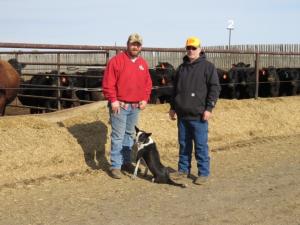Protecting water quality
“Conservation is huge; it’s always in the news. You want to make sure you are doing things the right way,” says Monte Bloms of Carpio, N.D.
Kindra Gordon is a writer from Whitewood, N.D.
Thus, when Bloms looked at establishing an animal feeding operation nearly two decades ago, he knew it was important to take the proper steps to ensure that the facility was designed to protect water quality and meet permit regulations.

Bloms grew up on a dairy and grain farm in the same north central North Dakota community – a farm his grandfather homesteaded. In 2000, he bought his own farm nearby, and began working with his dad, Bruce Bloms. They have farmland, run a cow-calf herd, and a dairy.
Monte’s farmstead included an existing feeding area, which prompted his interest in backgrounding and finishing their weaned calves. But before pursuing it, he had a state health department representative review the property and was told that with the watershed drainage into Lake Darling, the current facility would not be in compliance.
So, Bloms turned to the Mohall Natural Resources Conservation Service (NRCS) Field Office to discuss options for relocating the feeding facility to a better site on the farm that would reduce water management and runoff concerns. He was pleased with the technical assistance provided and through an Environmental Quality Incentives Program (EQIP) contract in 2007 received cost-share to reconstruct four pens and a dike system to accommodate 200 head.
Once this animal feeding operation was established, Bloms began to get more and more calls requesting him to do custom feeding. So, in 2010, once again working with the Mohall NRCS and an EQIP contract, Bloms moved ahead to expand to a concentrated animal feeding operation (CAFO) for 2,000 head.
Bloms received input from NRCS engineers and staff at the Mohall NRCS field office, and says, “It went as smooth as I could ask for. The expansion only took 18 months.”
Bloms’ feeding facility now includes a lined sediment pond and is permitted with the state. Of the process in working with NRCS, he expresses appreciation for the technical expertise, assistance with the permitting process and the cost-share assistance, which he says made it feasible to do the expansion.
Additionally, Bloms has added tree plantings throughout the years via his EQIP contracts to provide wind protection for the livestock. He tells, “My first introduction to NRCS was when my dad did a tree planting around our dairy long ago. It worked out great. Today, we’ve planted thousands of trees.” Bloms notes that NRCS staff have helped determine soil suitability for tree species; he likes spruce and pines but has found caragana and juneberries also make great windbreaks.
Bloms and his family have also relied on NRCS over the years in establishing a rotational grazing system and monitoring forage resources. Several years ago, to avoid spring weather impacts on calving, the Bloms transitioned their 300-head cowherd to fall-calving, which begins in August.
Bruce Baska, who has worked with the Mohall NRCS Field Office as a technician for 31 years, has worked with Monte's grandfather, Dad, and now Monte on implementing conservation practices throughout the years. Baska says, “I always enjoy working with the Bloms, protecting our natural resources has been a part of life on the Bloms’ farm for generations.”
Looking ahead, Bloms is now exploring establishing a compost site for the feedlot manure. He notes that they already use much of the manure on their own farmland, but often have more than they need each spring, which may mean future marketing opportunities exist. He has already consulted NRCS for technical advice in planning this venue and says they will be helpful in ensuring future efforts are compliant with regulations.

